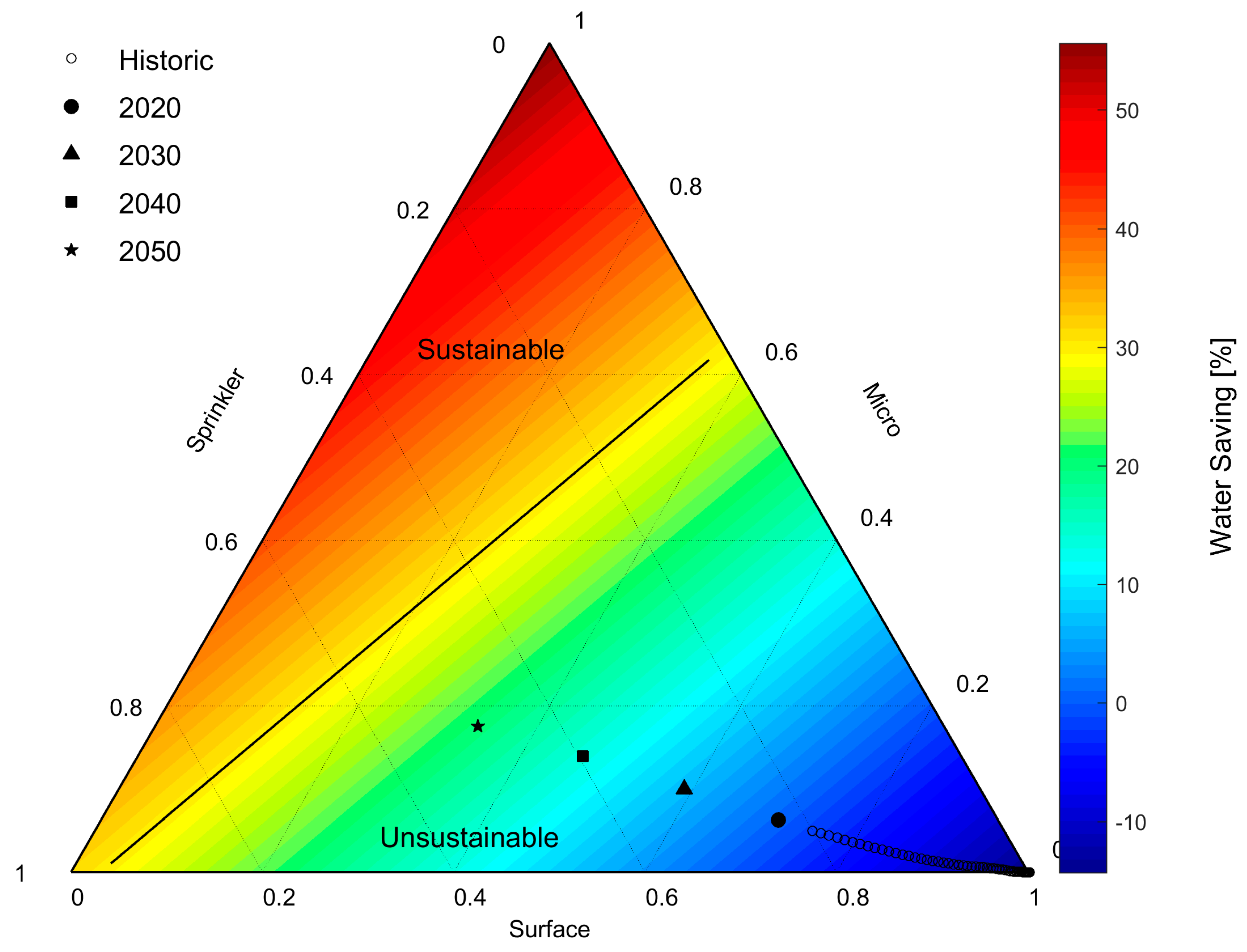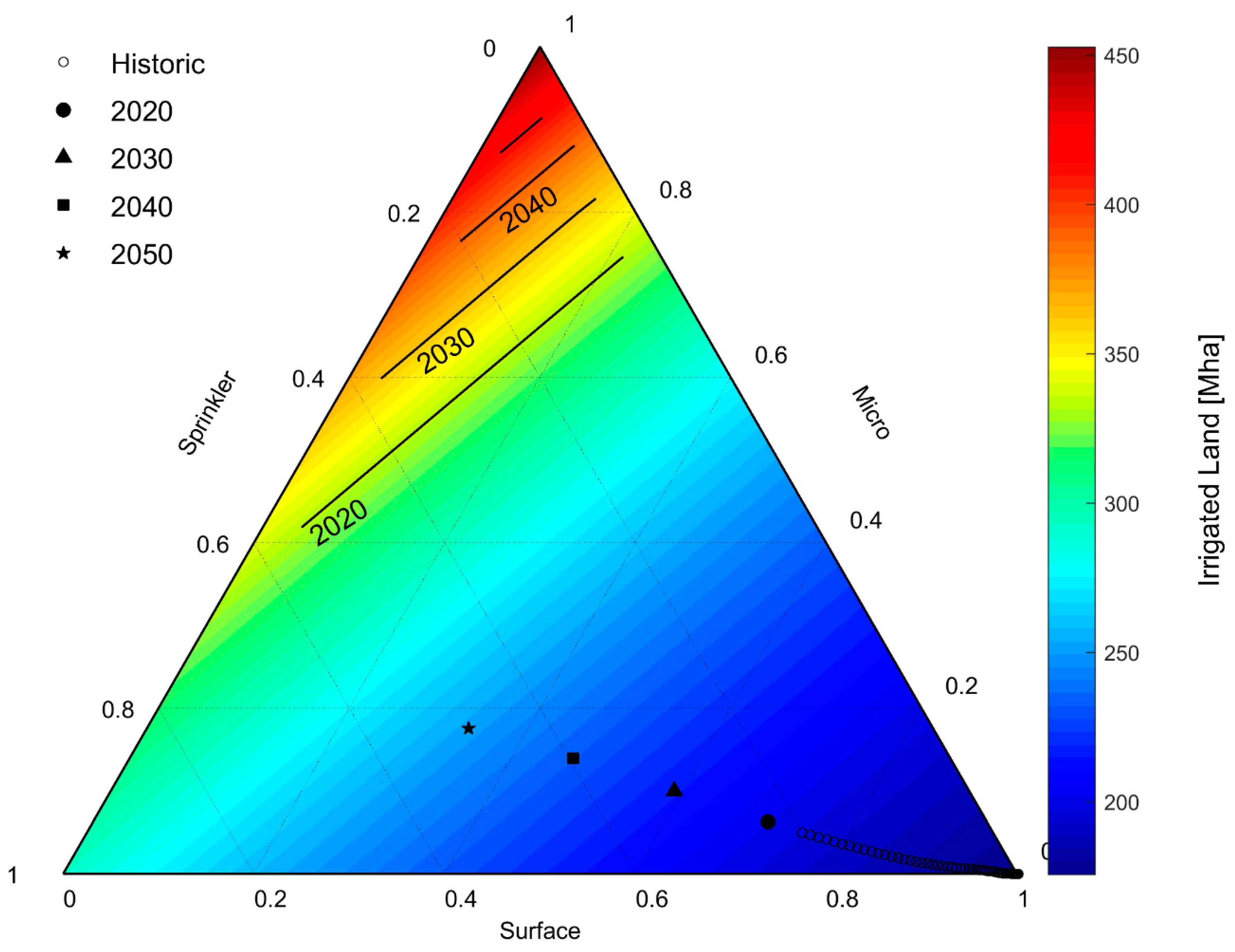A Pathway for Sustainable Agriculture
Abstract
1. Introduction
2. Methodology
2.1. Objective 1: Model Construction
2.2. Objective 2: Historical Data
Definition of Sustainability Horizon and Gap
3. Results and Discussion
3.1. Objective 3: Single Scenario Model Demonstration
3.2. Objective 4: Exploring Alternative Technological Scenarios
4. Conclusions
Supplementary Materials
Author Contributions
Funding
Institutional Review Board Statement
Informed Consent Statement
Data Availability Statement
Acknowledgments
Conflicts of Interest
References
- Finley, J.W.; Seiber, J.N. The Nexus of Food, Energy, and Water. J. Agric. Food Chem. 2014, 62, 6255–6262. [Google Scholar] [CrossRef]
- FAO. Building a Common Vision for Sustainable Food and Agriculture; FAO: Roma, Italy, 2014. [Google Scholar]
- Hillebrand, E. Poverty, Growth, and Inequality Over The Next 50 Years. In Proceedings of the Expert Meeting How to Feed World, Rome, Italy, 24–26 June 2009; Volume 2050, pp. 159–190. [Google Scholar]
- Koohafkan, P.; Altieri, M.A. Globally Important Agricultural Heritage Systems a Legacy for the Future; Rome Food Agriculture Organization United Nations (FAO): Roma, Italy, 2018. [Google Scholar]
- Goudie, A.S. Human Impact on the Natural Environment, 8th ed.; John Wiley & Sons: Hoboken, NJ, USA, 2018. [Google Scholar]
- Olsson, L.; Barbosa, H.; Bhadwal, S.; Cowie, A.; Delusca, K.; Flores-Renteria, D.; Hermans, K.; Jobbagy, E.; Kurz, W.; Li, D. 2019: Land Degradation. In Climate Change and Land: An IPCC Special Report on Climate D.J. Sonwa, L. Stringer, and Greenhouse Gas Fluxes in Change, Desertification, Land Degradation, Sustainable Land Management, Food Security, P.Z. Terrestrial Ecosystems; Shukla, P.R., Skea, J., Buendia, E.C., Masson-Delmotte, V., Pörtner, H.-O., Roberts, D.C., Slade, J.P.P.R., Connors, S., van Diemen, R., Ferrat, M., et al., Eds.; 2019, in press. Vyas, P.; Huntley, E.; Kissick, K.; Belkacemi, M.; Malley, J.; Land Degradation: IPCC Special Report on Climate Change, Desertification, Land 5 Degradation, Sustainable Land Management, Food Security, and 6 Greenhouse gas fluxes in Terrestrial Ecosystems; The Intergovernmental Panel on Climate Change: Geneva, Switzerland, 2019; p. 5043189. [Google Scholar]
- Kukal, M.S.; Irmak, S. Climate-Driven Crop Yield and Yield Variability and Climate Change Impacts on the U.S. Great Plains Agricultural Production. Sci. Rep. 2018, 8, 3450. [Google Scholar] [CrossRef]
- Flavelle, B.C. Climate Change Threatens the World’s Food Supply; United Nations Warns; The New York Times: New York, NY, USA, 2019. [Google Scholar]
- Malek, K.; Adam, J.C.; Stöckle, C.O.; Peters, R.T. Climate change reduces water availability for agriculture by decreasing non-evaporative irrigation losses. J. Hydrol. 2018, 561, 444–460. [Google Scholar] [CrossRef]
- Turral, H.; Burke, J.; Faurès, J.M. Climate Change, Water and Food Security; Water Reports, No. 36; Food and Agriculture Organization of the United Nations (FAO): Rome, Italy, 2011; p. 174. [Google Scholar]
- Grafton, R.Q.; Williams, J.; Perry, C.J.; Molle, F.; Ringler, C.; Steduto, P.; Udall, B.; Ann Wheeler, S.; Wang, Y.; Garrick, D.; et al. The paradox of irrigation efficiency. Science 2018, 361, 748–750. [Google Scholar] [CrossRef] [PubMed]
- Villalobos, F.J.; Fereres, E. Principles of Agronomy for Sustainable Agriculture; Springer: New York, NY, USA, 2016; p. 443457. [Google Scholar]
- Liu, J.; Hertel, T.W.; Lammers, R.B.; Prusevich, A.; Baldos UL, C.; Grogan, D.S.; Frolking, S. Achieving sustainable irrigation water withdrawals: Global impacts on food security and land use. Environ. Res. Lett. 2017, 12, 104009. [Google Scholar] [CrossRef]
- Owen, J. Farming Claims Almost Half Earth’ s Land, New Maps Show. Natl. Geogr. News 2005, 9, 100–125. [Google Scholar]
- UNESCO. The United Nations World Water Development Report 3: Water in a Changing World; UNESCO/Earthscan: Paris, France; London, UK, 2009. [Google Scholar]
- Rosegrant, M.W.; Cai, X.; Cline, S.A.; Nakagawa, N. The Role of Rainfed Agriculture in the Future of Global Food Production; No. 581-2016-39482; International Food Policy Research Institute: Washington, DC, USA, 2002. [Google Scholar]
- Mateos, L. Irrigation Systems BT—Principles of Agronomy for Sustainable Agriculture; Villalobos, F.J., Fereres, E., Eds.; Springer International Publishing: Cham, Switzerland, 2016; pp. 255–267. [Google Scholar]
- Chimonides, S.J. Irrigation management under water shortage conditions. In Proceedings of the EWRA 95 Symposium, Nicosia, Cyprus, 14–18 March 1995; pp. 73–78. [Google Scholar]
- Ibragimov, N.; Evett, S.R.; Esanbekov, Y.; Kamilov, B.S.; Mirzaev, L.; Lamers, J.P.A. Water use efficiency of irrigated cotton in Uzbekistan under drip and furrow irrigation. Agric. Water Manag. 2007, 90, 112–120. [Google Scholar] [CrossRef]
- O’Neill, C.J.; Humphreys, E.; Louis, J.; Katupitiya, A. Maize productivity in southern New South Wales under furrow and pressurised irrigation. Aust. J. Exp. Agric. 2008, 48, 285–295. [Google Scholar] [CrossRef]
- Humphreys, E.; White, R.J.G.; Smith, D.J.; Godwin, D.C. Evaluation of strategies for increasing irrigation water productivity of maize in southern New South Wales using the MaizeMan model. Aust. J. Exp. Agric. 2008, 48, 304–312. [Google Scholar] [CrossRef]
- Al-agele, H.A.; Proctor, K.; Murthy, G.; Higgins, C. A Case Study of Tomato (Solanum lycopersicon var. Legend) Production and Water Productivity in Agrivoltaic Systems. Sustainability 2021, 13, 2850. [Google Scholar] [CrossRef]
- Thompson, R.B.; Incrocci, L.; van Ruijven, J.; Massa, D. Reducing Contamination of Water Bodies from European Vegetable Production Systems; Elsevier: Amsterdam, The Netherlands, 2020. [Google Scholar]
- Berkhout, P.; van Bruchem, C. Agricultural Economic Report 2009 of the Netherlands: Summary; No. 2009-066; LEI WUR: The Hague, The Netherlands, 2009. [Google Scholar]
- Parod, R.W.; Provaznik, R.E.; Cook, K.I. Automated Adjustable Drop Hose for Mechanized Irrigation. U.S. Patent 9,974,245, 22 May 2018. [Google Scholar]
- Al-agele, H.A.; Mahapatra, D.M.; Prestwich, C.; Higgins, C.W. Dynamic Adjustment of Center Pivot Nozzle Height: An Evaluation of Center Pivot Water Application Pattern and the Coefficient of Uniformity. Appl. Eng. Agric. 2020, 36, 647–656. [Google Scholar] [CrossRef]
- AL-agele, H.A.A.; Nackley, L.; Higgins, C. Testing Novel New Drip Emitter with Variable Diameters for a Variable Rate Drip Irrigation. Agriculture 2021, 11, 87. [Google Scholar] [CrossRef]
- Shamshery, P.; Wang, R.Q.; Tran, D.V.; Winter, V.A.G. Modeling the future of irrigation: A parametric description of pressure compensating drip irrigation emitter performance. PLoS ONE 2017, 12, e0175241. [Google Scholar] [CrossRef] [PubMed]
- Gustavsson, J.; Cederberg, C.; Sonesson, U.; Van Otterdijk, R.; Meybeck, A. Global Food Losses and Food Waste; FAO: Rome, Italy, 2011. [Google Scholar]
- Siebert, S.; Döll, P. Quantifying blue and green virtual water contents in global crop production as well as potential production losses without irrigation. J. Hydrol. 2010, 384, 198–217. [Google Scholar] [CrossRef]
- Siebert, S.; Kummu, M.; Porkka, M.; Döll, P.; Ramankutty, N.; Scanlon, B.R. A global data set of the extent of irrigated land from 1900 to 2005. Hydrol. Earth Syst. Sci. 2015, 19, 1521–1545. [Google Scholar] [CrossRef]
- Sivanappan, R.K. Irrigation Water Management for Sugarcane; Vasantdada Sugar Institute: Maharashtra, India, 1998; p. II. [Google Scholar]
- Rudnick, D.; Irmak, S. Impact of water and nitrogen management strategies on maize yield and water productivity indices under linear-move sprinkler irrigation. Trans. ASABE 2013, 56, 1769–1783. [Google Scholar]
- Press, W.H.; William, H.; Teukolsky, S.A.; Saul, A.; Vetterling, W.T.; Flannery, B.P. Numerical Recipes 3rd Edition: The Art of Scientific Computing; Cambridge University Press: Cambridge, UK, 2007. [Google Scholar]
- Turner, R.K.; Georgiou, S.; Clark, R.; Brouwer, R.; Burke, J.J. Economic Valuation of Water Resources in Agriculture: From the Sectoral to a Functional Perspective of Natural Resource Management; Food and Agriculture Organization of the United Nations: Roma, Italy, 2004. [Google Scholar]
- Parlin, B.W. Farmer Participation And Irrigation Organization; CRC Press: Boca Raton, FL, USA, 2019. [Google Scholar]
- O’Brian, D.M.; Lamm, F.R.; Stone, L.R.; Rogers, D.H. The Economics of Converting from Surface to Sprinkler Irrigation for Various Pumping Capacities. 2000. Available online: http://hdl.handle.net/2097/21774 (accessed on 10 December 2020).
- Nakawuka, P.; Langan, S.; Schmitter, P.; Barron, J. A review of trends, constraints and opportunities of smallholder irrigation in East Africa. Glob. Food Sec. 2018, 17, 196–212. [Google Scholar] [CrossRef]
- Okada, M.; Iizumi, T.; Sakamoto, T.; Kotoku, M.; Sakurai, G. Earth’s Future Varying Bene fits of Irrigation Expansion for Crop Production Under a Changing Climate and Competitive Water Use Among Crops. Earth’s Future 2018, 9, 1207–1220. [Google Scholar] [CrossRef]
- Murray, A. Meat cultures: Lab-grown meat and the politics of contamination. Biosocieties 2018, 13, 513–534. [Google Scholar] [CrossRef]
- Liceaga, A.M. Approaches for Utilizing Insect Protein for Human Consumption: Effect of Enzymatic Hydrolysis on Protein Quality and Functionality. Ann. Entomol. Soc. Am. 2019, 112, 529–532. [Google Scholar] [CrossRef]
- Fleurence, J.; Morançais, M.; Dumay, J. 9—Seaweed Proteins. In Proteins in Food Processing; Woodhead Publishing: Sawston, Cambridge, UK, 2018; pp. 245–262. [Google Scholar]
- Adeh, E.H.; Selker, J.S.; Higgins, C.W. Remarkable agrivoltaic influence on soil moisture, micrometeorology and water-use efficiency. PLoS ONE 2018, 13, e0203256. [Google Scholar]




Publisher’s Note: MDPI stays neutral with regard to jurisdictional claims in published maps and institutional affiliations. |
© 2021 by the authors. Licensee MDPI, Basel, Switzerland. This article is an open access article distributed under the terms and conditions of the Creative Commons Attribution (CC BY) license (https://creativecommons.org/licenses/by/4.0/).
Share and Cite
AL-agele, H.A.; Nackley, L.; Higgins, C.W. A Pathway for Sustainable Agriculture. Sustainability 2021, 13, 4328. https://doi.org/10.3390/su13084328
AL-agele HA, Nackley L, Higgins CW. A Pathway for Sustainable Agriculture. Sustainability. 2021; 13(8):4328. https://doi.org/10.3390/su13084328
Chicago/Turabian StyleAL-agele, Hadi A., Lloyd Nackley, and Chad W. Higgins. 2021. "A Pathway for Sustainable Agriculture" Sustainability 13, no. 8: 4328. https://doi.org/10.3390/su13084328
APA StyleAL-agele, H. A., Nackley, L., & Higgins, C. W. (2021). A Pathway for Sustainable Agriculture. Sustainability, 13(8), 4328. https://doi.org/10.3390/su13084328







